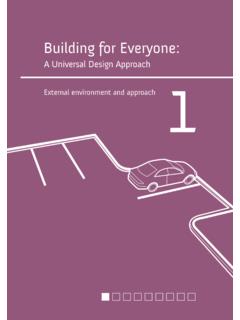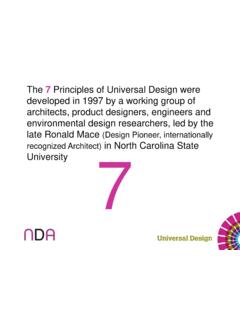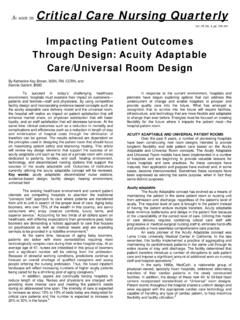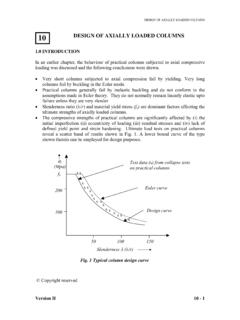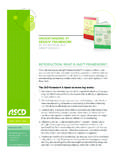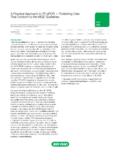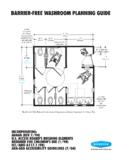Transcription of A Universal Design Approach 7
1 Building for Everyone:A Universal Design Approach Building types7 IICentre for Excellence in Universal DesignCreating an environment that can be used by all people, regardless of their age, size, disability or National Disability Authority s Centre for Excellence in Universal Design has a statutory role to promote the achievement of excellence in Universal Design in: the Design of the built and external environment product/service Design information and communications technologies (ICT) the development and promotion of standards education and professional development raising awareness of Universal designMore information and updates on the website at: for EveryoneBooklet 7 - Building typesThe other booklets from the Building for Everyone series:Booklet 1 - External environment and approachBooklet 2 - Entrances and horizontal circulation Booklet 3 - Vertical circulationBooklet 4 - Internal environment and servicesBooklet 5 - Sanitary facilities Booklet 6 - Facilities in buildingsBooklet 8 - Building management Booklet 9 - Planning and policyBooklet 10 - Index and terminology II Contents Objectives Introduction Terminology Design Issues Transport Buildings 11 Location 12 Size and layout 13 Passenger facilities 16 Travel information Office Buildings 23 Entrances and circulation 23 Internal environment 24 Workstations and storage Retail Outlets and Shopping Centres 27 Internal circulation 27 Display and storage in shops 28 Counters and checkouts 31 Fitting rooms 34 Equipment and assistance in shops Restaurants.
2 Bars and Caf s 39 Layout and seating 40 Self-service facilities 42 Customer service and management 44 Outdoor smoking areas Museums, Galleries and Libraries 47 Information and interpretation 49 Displays and exhibits 51 III Contents Objectives Introduction Terminology Design Issues Transport Buildings 11 Location 12 Size and layout 13 Passenger facilities 16 Travel information Office Buildings 23 Entrances and circulation 23 Internal environment 24 Workstations and storage Retail Outlets and Shopping Centres 27 Internal circulation 27 Display and storage in shops 28 Counters and checkouts 31 Fitting rooms 34 Equipment and assistance in shops Restaurants, Bars and Caf s 39 Layout and seating 40 Self-service facilities 42 Customer service and management 44 Outdoor smoking areas Museums, Galleries and Libraries 47 Information and interpretation 49 Displays and exhibits 51 Study areas 54 Library shelving Entertainment, Conference and Lecture Facilities 59 Audience seating 60 Performers facilities 63 Speakers facilities Religious Buildings 65 Facilities for seating and prayer 67 Other facilities in religious buildings Hotel.
3 Guest and Residential Accommodation 69 Bedrooms 71 Bathrooms Housing 80 Car parking 81 Setting-down points 82 External Approach 83 Entrances 85 Horizontal circulation in housing 87 Vertical circulation in housing 89 Services in housing 92 Individual rooms Historic Buildings and Sites 94 Conservation principles 97 Making changes to historic buildings 98 Detailed Design of historic buildings 99 Entrances 99 Doors 100 Ramps 100 Staircases 101 Platform lifts Outdoor Access 104 Types of landscape 107 Natural landscape 107 Tempered landscape 109 Urban landscape 110 Tamed landscape 110 Mountains 112 Peatlands 115 Beaches 116 Conservation areas 117 Viewing points 118 Country parks 120 Woodlands and arboreta 122 Picnic areas 125 Campsites and caravan parks 126 Waterways 127 Archaeological sites 130 T emporary events 130 Parks 132 Cemeteries 133 Playgrounds, play structures and equipment 134 Gardens and courtyards 136A1 Definition of Universal Design 139A2 Human Abilities and Design 139A3 Further Reading 144 List of Illustrations 148 Index 1495 Objectives The guidance in this booklet promotes the concept and philosophy of Universal Design and encourages developers, designers.
4 Builders and building managers to be innovative and think creatively about solutions that meet the needs of all building objectives of the series of booklets are to: identify and promote best practice with regard to Universal Design of the built and external environment provide best practice guidelines that in no way conflict with the requirements of existing regulations in Ireland provide guidelines that are usable by and accessible to the target audience promote Universal Design in IrelandThis booklet aims to: identify and promote best practice for access to and understanding of the Design of a wide range of buildings with regard to Universal Design increase awareness of, and to encourage designers to identify, the needs of all those who require access to a wide range of buildings to undertake daily activities highlight the wider benefits experienced by all when accessible and Universal designed features of buildings are provided encourage designers to provide Universal Design solutions for a wide range of buildings that look beyond the minimum requirements of national building regulations6 Introduction This booklet is part of the series Building for Everyone A Universal Design Approach , which aims to provide practical guidance on the Universal Design of buildings, places and facilities.
5 Universal Design places human diversity at the heart of the Design process so that buildings and environments can be designed to meet the needs of all users. It therefore covers all persons regardless of their age or size and those who have any particular physical, sensory, mental health or intellectual ability or disability. It is about achieving good Design so that people can access, use and understand the environment to the greatest extent and in the most independent and natural manner possible, without the need for adaptations or specialised solutions (see full definition in Appendix A1). Why Universal Design ?People are diverse - some are left-handed and some right-handed - and people vary in their age, size and functional capacities. Illness or disability (whether temporary or permanent) can also affect characteristics such as people s mobility, dexterity, reach, balance, strength, stamina, sight, hearing, speech, touch, knowledge, understanding, memory, or sense of direction.
6 A reference list with these booklets indicates some of the key differences in human abilities that should guide Design of buildings and of outdoor places. (See full description of Human Abilities in Appendix A2). People of diverse abilities should be able to use buildings and places comfortably and safely, as far as possible without special assistance. People should be able to find their way easily, understand how to use building facilities such as intercoms or lifts, know what is a pedestrian facility, and know where they may encounter traffic. Given the wide diversity of the population, a Universal Design Approach that caters for the broadest range of users from the outset can result in buildings and places that can be used and enjoyed by everyone. That Approach eliminates or reduces the need for expensive changes or retro fits to meet the needs of particular groups at a later stage. 7It is good practice to ascertain the needs of the range of expected users as early as possible, and to check the practicality and usability of emerging designs with a diverse user panel.
7 Designing for one group can result in solutions that address the needs of many others. For example: level entry (Step-free) entrances facilitate not just wheelchair users but also people with buggies; people with suitcases or shopping trolleys; people using walking or mobility aids; and people with visual difficulties larger toilet compartments provide easier access to wheelchair users; those with luggage or parcels; parents with pushchairs or accompanying small children; those using walking or mobility aids; and larger-sized people. clear, well-placed signage that uses recognised symbols or pictograms helps people with reading or cognitive difficulties, and those whose first language is neither English nor IrishSometimes one solution will not suit all and a range of options will need to be provided, for example: providing both steps and a ramp where there is a change in level providing parking ticket machines that offer slots at different heights to facilitate use at standing height, at sitting height, and by people of small statureThis series of booklets is for architects, engineers, planners, developers, designers, building contractors, building workers, building managers and others involved in designing, commissioning and managing buildings and their surroundings.
8 It provides guidance on a Universal Design Approach to all new buildings, and the use and adaptation of existing environments. Those who commission, Design , construct or manage any part of the built and made environment also have a duty of care to adhere to relevant legislation and regulations including equality legislation, building regulations and health and safety regulations. 8 The guidance is based on a best practice Approach drawing on up to date international best practice, guidelines and standards; previous guidance by the National Disability Authority; and extends beyond disability access matters to incorporate a Universal Design Approach . The series is fully compatible with Part M (2010) of the Building Regulations and associated Technical Guidance Documents related to Part disability access certificate is required for new buildings other than dwellings (including apartment buildings) and certain other works (as set out in Article 20 D (1) of SI 351 of 2009) to which the Requirements of Part M of the Building Regulations apply, which commence or take place on or after 1 January 2012.
9 Further details on these and other relevant standards, codes of practice, and professional codes of practice are listed in Appendix A3 Further detailed guidance provided here does not represent the only possible solution. Designers may come up with other ways to meet a diversity of users. New materials and technologies that emerge may open up further possibilities of accommodating the diversity of the are provided throughout the series and while they provide a summary of main considerations and technical criteria, they should not be regarded as a substitute for the main text or an exhaustive list. A comprehensive index is available with the suite of booklets. The Building for Everyone series is available online at and Electronic links are provided to relevant sections in the different booklets. As standards and requirements develop, the electronic versions of these booklets will be electronic version is produced in accessible PDF format in accordance with the Web Content Access Guidelines If you have any difficulties in this regard or require the document, or particular sections, in alternative formats, please contact the Centre for Excellence in Universal Design at the National Disability Authority, or (01) Terminology Accessible Facilities Facilities that are designed for all users of a building or external environment, including the young and old, and those of all sizes, abilities, and disabilities.
10 Building user A person regardless of age, size, ability or disability using facilities in a building or associated external framing member A horizontal bar running across a core A standard industry term for the lift/lift shaft used to service an apartment complex / multi-story The base or platform upon which a structure or fixed furniture fixture, such as a cupboard, The degree to which seating in an auditorium or theatre slopes. A seating rake is where the seats are on terraces (so they slope overall), rather than flat on the floor. This helps sight lines and means you can see over the people in front of A horizontal crosspiece across a window or separating a door from a window over Design Issues Every building has a particular function or range of functions, and its Design should ensure that people working in or visiting the building can access and use its buildings or parts of buildings, such as shops and offices, have only one specific function and should generally conform to guidelines pertinent to these building types.
